
Cities of Stone
If only to have seen them in
their prime
D uring all of my previous tours I did my best to avoid cycling through large cities. That was, in part, a result of my upbringing in the United States, where cities are frequently useless, not to mention generally unwelcoming, to cyclists. On the Tour of Gondwana, however, I began to relax that policy. That was partly out of necessity, as in most places there is no way to easily bypass big cities, and partly because I did indeed want to experience whatever they had to offer. So I often found myself rolling through the bewildering chaos of small towns and mega-cities, those up high or down low, from Agra to Ziway. To be sure, they provided essential services, occasionally good food, and a sometimes decent place to clean up, and a few contained exceptional places of interest. But, beyond that, I found most of them to be entirely forgettable.
On the other hand, when I had the opportunity to
ride to, and through, the remains of a great city from ages past, I did my best to make the most of it. For, without a doubt, the human settlements of bygone days, even in the crumbling states in which they exist in our time, provided a much more appealing experience. The remains that can still be seen represent only a portion of their former extent, and one's imagination is definitely required in order to appreciate how they might have appeared in their heydays. All of the sites that were along my route had a few things in common. Among those was the stone construction used for their central civic areas, which constitute the only areas of the cities still visible today. The residential, market, and agricultural zones of these cities were almost certainly built from less durable materials, and so degraded long ago. Almost without fail, the stone portions of the cities consisted of temples or other community-building structures, as opposed to the palaces or utilitarian buildings which came to dominate the cities of later eras. A final factor that stands out for a cyclist, such as me, was the human-scaled design of these towns. There were grand buildings, to be sure, but a solitary human, on a bike, or otherwise, would never have felt out of place, as is so often the case in today's high-rise, auto-choked metropolises. Certainly, that would be expected, given the era in which they were built, but that fact doesn't change the pleasantness of thier design. Here are, in order of my visit, the finest examples that I saw during the Tour of Gondwana.
Ayutthaya
With most of Stage 1 taking place in Australia, a land that is either modern or arid and unpopulated, it was not until well into Stage 2 that I reached the first ancient city of the Tour, namely Ayutthaya, located just north of Bangkok, Thailand. Ayutthaya was the capital city of a nation of the same name, though the land also became known as Siam, the precursor of modern Thailand. It was founded in the mid 14th century, and lasted for over 400 years, until it was destroyed during an invasion by the neighboring Burman army. The original city was distinct in that it contained a network of canals, presumably used for transport, though there are few visible remains of that network today. Still present from the city are many of its temples, in various states of preservation. Generally tall stone structures, some are shaped in the style of a classic Buddhist stupa, with a wide base, tapering upwards to a sharp point. Others are reminiscent of the Khmer structures of Cambodia, themselves derived from Hindu towers. I was very impressed by the access given to visitors, including entrance to a few underground chambers, where ancient frescoes could just barely be seen. Today the ruins site is easily accessed from the nearby modern town of the same name, though it is spread out over a few large, but separate, locations. Having one's own bike handy make visiting the ruins much more pleasant, though there are plenty of other transport options, including elephant rides, available.
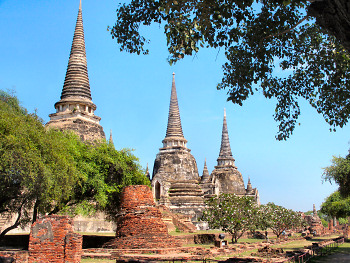
Wat Phra Si Sanphet, in old Ayutthaya
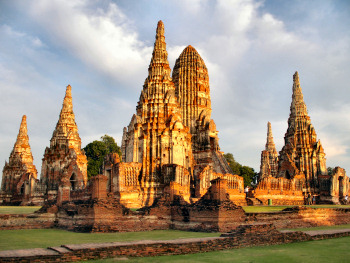
Wat Chaiwatthanaram, in old Ayutthaya
Angkor
Once I had decided that I would include South Asia on the tour route there was never any question that I would visit the amazing ruins of Angkor, in Cambodia. For around 600 years, starting around 800 C.E., that site was the capital of the Khmer Empire, which at the time was one of the most successful nations on Earth. The complex, which was constructed in stages over the centuries, contains many magnificent Hindu-inspired structures that probably functioned as both temples and administrative buildings. These are justifiably famous for their grand architecture and elaborate stone decorations, the latter usually depicting mythological figures or historical scenes. Later, simpler, Buddhist-styled structures found their way into the city. The result was a huge city, of which around 70 major temple ruins remain today, along with hundreds of minor structures, spread out over many square kilometers. However, the actual city was considerably larger. Results of an investigation employing advanced imaging techniques, released in 02007, not long after I visited, revealed that the less durable areas of the city extended over a huge area, housing perhaps a million people. Therefore, Angkor was possibly the largest city evern seen in the pre-industrial World.
Today, visiting is quite an exceptional and enjoyable experience. Even more so when one brings their own bike. The gateway town of Siem Reap is predictably hectic and filled with no end of ways for one to become separated from their money. At the time of my Tour, it was also reachable only by a rather poor-quality dirt/gravel road, though I have heard that upgrades are finally under way. However, once one completes the short, easy ride out to the archeological zone, the feeling changes completely. The site is large enough to allow one to easily escape the crowds of visitors from time to time, and the controlled level of traffic makes cycling around the very flat site a real treat. In fact, the only real distractions, though usually pleasant ones, are the local ladies shouting at passing cyclists trying to get them to purchase their fresh-cut pineapples.
Once the city had been abandoned in the 15th century, after an invasion by the Thais, the temples began to be reclaimed by the local variety of tropical forest. Today, the trees are impressively large, and many provide iconic images of ancient temples being strangled by their roots. While the shade they provide was certainly welcome, their height has eliminated any possibility of seeing a panoramic view of the entire site, at least without using aircraft, which was perhaps the only disappointing aspect of the area. In two days, I did quite well in terms of seeing most of the major buildings, thanks to my bike, and I also visited one of the outlying sites on the way out of the area. However, in a mistaken attempt to "save the best for last", I planned on visiting the largest and most famous temple, Angkor Wat at the end of the second day. Underestimating the size of the site, and neglecting to factor in the rapidity of tropical sunsets, by the time I reached the center of that huge temple I had only enough time for a rather rushed exploration. Perhaps I can manage a return visit someday to take a more detailed look.
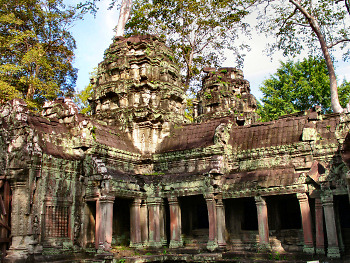
Ta Prohm temple, Angkor complex
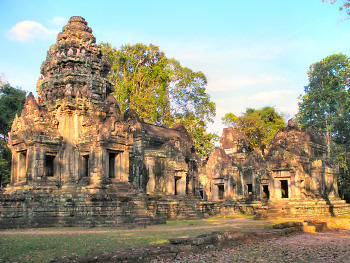
Thommanom temple, Angkor complex
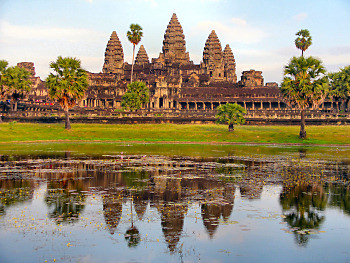
Angor Wat, centerpiece of the Angkor area
Sukhothai
Sukhothai was the capital city of an early Thai kingdom for 140 years, beginning in 1238 C.E. At the end of that period its control was ceded to Autthaya. Since its heyday did not last long, relative to other great capitals, it did not grow to be quite as large as some of its neighbors. Nevertheless, there have been close to 200 temples restored, most of which are decidedly Buddhist in design. Today the ruins are preserved in a pleasant archeological park, which aptly presents their aesthetic qualities. Most of the ruins were either plainly built, or have since lost their ornamentations, so this site is not very well suited for close examinations. Instead, the structures are best admired in relation to their surroundings from a moderate distance, which is perfectly accomplished by cycling around the park. In so doing, one gains a definite appreciation for the beautiful, human-scaled layout of the city's urban plan.
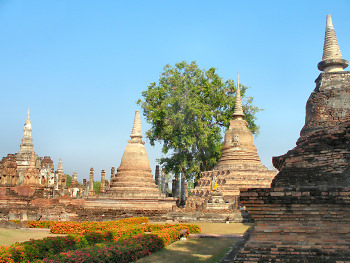
Wat Mahathat, in old Sukhothai
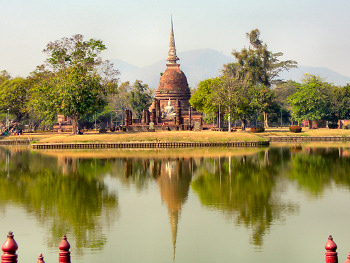
Wat Sa Si, in old Sukhothai
Bagan
I was aware of Bagan's reputation as an outstanding historic site even before the Tour began, and so I expected to enjoy my visit. As with all of the other cultural sites I saw in Myanmar, reality exceeded my expectations by an order of magnitude, at least. Bagan was the greatest city of the Ayerawaddy Valley region and surrounding areas, during the period from around 850 C.E. until it was vanquished by the Mongol armies in 1287, and for much of that time it was the capital of the Burman Empire. Built on around 40 square kilometers of plains along the Ayerawaddy River, the city, even in the partially neglected state in which it exists today, is incomparable in its beauty. Today there are around 2,200 pagodas and temples of various sizes, amounts of ornamentations, and levels of restoration, in the city. However, I have seen accounts that at the time of its fall, the city had over 10,000 such structures. Many of those have been lost due to the encroachment of the river, damage from earthquakes, or vandalism. The vistas available at that time must have been absolutely unbelievable, because those presented at this time are nearly so.
The site today exhibits many aspects that made it perhaps my favorite. Among those is the climate of the region, which causes the foliage of the area to be smaller and thinner than that at Angkor, allowing for the aforementioned incredible vistas of the entire city. Also, many of the most important temples are still used as spiritual centers by the local people, a situation that always makes an historic site seem much more appealing to me. The generally low-key feel of the tourist facilities and lack of crowds at the site, both caused largely by the mismanagement of country's inept military government, made visiting the site a very relaxing, as well as a fascinating, experience. As with the previous two ancient cities, having a bike at Bagan made seeing the ruins much more enjoyable. Some type of transport is essential, as the city is very large and the distances between the major temples can be lengthy, but with one's own bike it is possible to set a pace that is comfortable and see the all of temples that are most appealing. Had I known just how magnificent the site would be, I would have budgeted more time for my visit. The two partial days I spent at the ruins were not quite enough, at least to start. However, the next day the rest of my ride in the country was to be shortened by a wrong turn, and an annoying government prohibition against foreigners lodging in the only town I reached that day. The result was an extra day available to see the ruins while I arranged transport back to Yangon. With that extra day, I was satisfied with my visit to the site, though I could certainly have spent a week or more there.
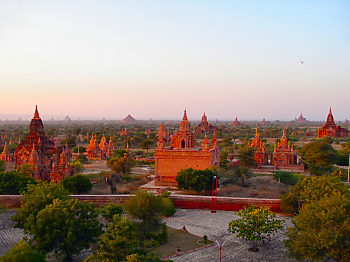
A vista across the ancient city of Bagan
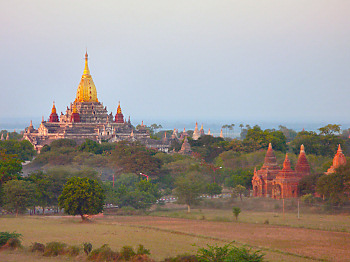
Ananda Temple and surrounding pagodas in Bagan
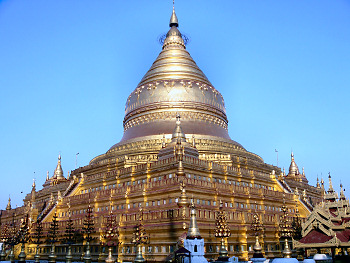
Shwezigon Paya, Bagan
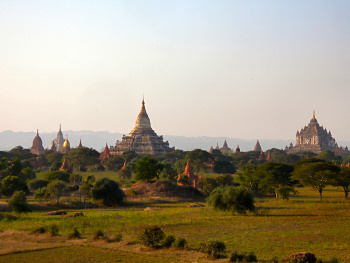
A beautiful vista at Bagan
Vijayanagara (Hampi)
India has many cities which date back many hundreds of years. However, in most of those cases only a few historic buildings remain, mixed in with the jumble of modern chaos that is found in most Asian cities today. There are, sadly, relatively few examples of ancient cities which have been preserved over most their entire original extents. One of those is the ruins of Vijayanagara, known today as Hampi. Vijayanagara was located in what is now the Karnataka state in southwestern India. The city was the capital of an empire with the same name, and was at its height between the 14th and 16th centuries, until it fell due to conflict with neighboring states.
I was surprised at the size and beauty of the site, and I was fortunate that I employed the services of a local taxi as a guide, as I probably would not have been able to locate all of the important structures on my own. There are fine examples of stone-built temples, buildings, and artistic works, of various styles, spread around an area of several square kilometers. In fact, at its peak it was said to be the largest city in India and one of the largest in the World. As with Bagan, a few of the main temples are still in use by the people of the area, which I enjoyed seeing. Another thing that appealed to me was the way the generally pale brown stonework of the city's buildings blended in nicely with the many rocky outcrops and hills that border the site. That fact made it pleasingly difficult to tell where the city ended and the surrounding countryside began.
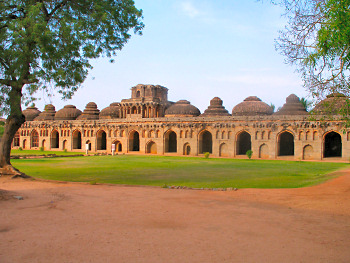
Elephant Stables at Hampi
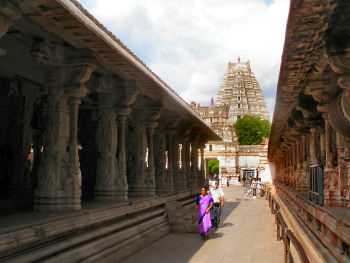
Virupakshawa Temple, Hampi
Pattadakal
The nearby town of Pattadakal, also in Karnataka state, contains a smaller, but certainly no less intriguing collection of temple ruins. Never an especially large city, Pattadakal was, nonetheless, a part of the capital of the influential Chalukya dynasty during the 7th and 8th centuries C.E. There are ten temple ruins remaining at the site today, and they are famous, in part, for their blend of northern and southern Indian architectural styles. I was not always able to tell which was which, but I found them all appealing in any case. Notable were the excellent stone carvings, rich with detail, and probably the oldest examples of those that I saw during the Stage. Another thing that I appreciated was that the site is located in a very rural district, and so visiting did not involve the noise and crowds that often came with visits to other sites in India.
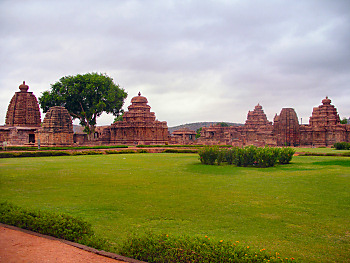
Temples at Pattadakal
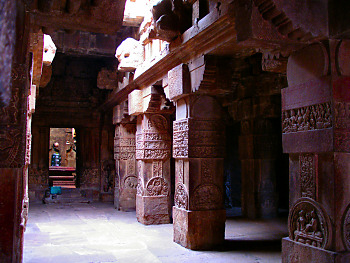
Interior of Virupakshal Temple at Pattadakal
Lalibela
Though the historic site at Lalibela, Ethiopia was never part of a large city it certainly can be included with the others on this page for the sheer audacity of its most famous constructions. A main reason that the town never grew to be a large population center is its tenuous location atop a rocky mountain. It is that location, however, that also led to the towns most important structures, the eleven rock-hewn churches carved directly out of the granite outcrops on the mountaintop. Two more were created in outlying villages. It really is hard to describe the uniqueness of these beautiful buildings. While all of the other cities I saw were constructed by arranging carved stone blocks or bricks, the Lalibela churches really are large monoliths. That sounds impressive enough, but the scale of the buildings, with tall columns, high archways, and vaulted ceilings, made their creation all the more astounding. I have heard, from time to time over the years, commentators state that sub-Saharan Africa never produced any important civilizations or great works of architecture. Those who think that way have obviously never seen Lalibela, for the aesthetic qualities of these churches, and the required engineering skills needed to create them, are on a par with that of any other ancient society.
The churches were believed to have been built during the 12th and 13th centuries, in the reign of King Lalibela. It is said that they were created to be a part of a "New Jerusalem" after that city had been conquered by Islamic forces. Today, the town is an important sacred site for Ethiopia, and the churches are still in use, though their designs more closely resemble temples than the assembly-hall-style of a typical western church. Cycling to Lalibela is no simple task, though. It is located at the end of a dead end road branching off from a longer, unimproved highway, and the final climb up to the mountaintop is quite steep. Despite the effort required, I considered my visit to be absolutely worthwhile.
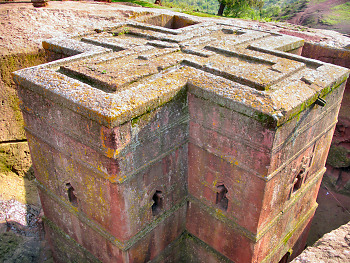
Bete Giyorgis at Lalibela
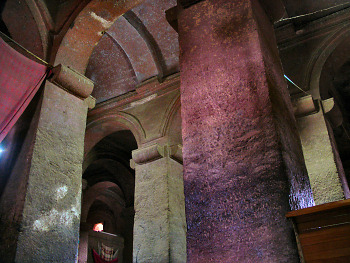
Interior of Bete Medhane Alem at Lalibela
Tiwanaku
Despite the fact that South and Central America
contain some of the finest ancient stone cities to be found anywhere, it took me many months of strenuous cycling in Stage 4 before I reached the first example on my route, Tiwanaku, in northern Bolivia. Located close to the beautiful shores of Lake Titicaca, a culturally significant body of water, the city was the capital of an important regional state in the period from about 300 to 1000 C.E. Compared to some other ancient cities, relatively little is known about the people and history of Tiwanaku, but its residents were almost certainly the ancestors of the Aymara population of modern Bolivia. Today the site, which was an easy ride from the Bolivian capital, La Paz, more closely resembles an ongoing archeological excavation site compared to some of the others I visited. A few large plazas have been restored, and a some large monolithic sculptures remain at the site, as does a stone portal covered with interesting hieroglyphs. The main feature of the city, the Akapana stepped pyramid, was in the early stages of excavation while I was there, a process that will undoubtedly take many years. I rather enjoyed seeing the process in action, however, especially since many of the workers were ordinary people from the nearby village. While not the largest site I saw in the region, the ruins gave a good introduction to what was still to come on the continent.
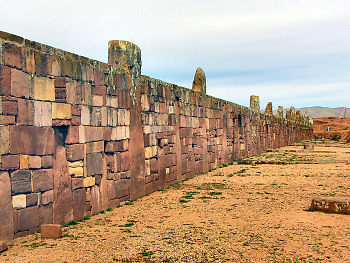
Kalasasaya Observatory at Tiwanaku
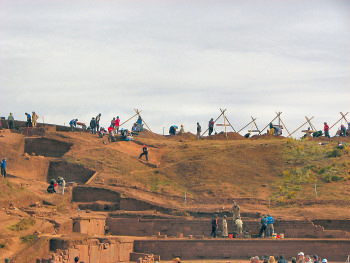
Excavation and restoration of Akapana Pyramid at Tiwanaku
Chavin de Huantar
Chavin de Huantar was an important political center for the Chavin culture of early Peru. While never a very large town, it is significant in that it represents one of the earliest known societies in the region and may perhaps be the originator of the artistic and architectural styles used by subsequent civilizations throughout the Andean and meso-American regions. The temples and other structures of the site are thought to have been built around 900 B.C.E., and continued to function for another five to six hundred years. The site today, is not at its best, since many of the most interesting stone works have been removed for display in various distant museums. However, the interesting subterranean labyrinths are still open to visitors, though without most of the artifacts that must have filled them at one time. Visiting the town required a rather exhausting detour from the most direct route through the country, as the site lies east of the Cordillera Blanca range at an elevation of 3,100 meters.
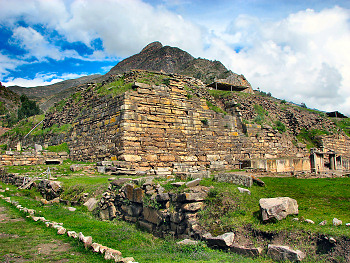
New Temple ruins at Chavin de Huantar
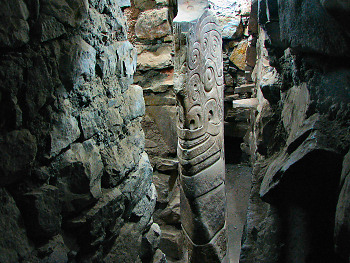
The Lanzon Monolith in a subterranean labyrinth at Chavin
Cusco
The greatest and most well known nation of
pre-colonial South America was, of course, the Incas. They developed a distinctive and very impressive style of stonemasonry, perhaps the best the World has ever seen. Despite the wide area encompassed by their empire and their society's wealth and sophistication, Inca cities were relatively few and comparatively small in size. Though what they lacked in scale, they made up for with numerous minor towns and sanctuaries, and ruins sites are today found in many places around their former realm. A possible reason for this could simply be terrain, as the rugged Andes certainly would seem to make building large cities a little counterproductive. Their capital, Cusco, was by all accounts an exceptional city, nevertheless. Founded in the 13th century, it flourished until civil war and the Spanish Conquest ended the Inca Empire in the 01530's. In a very atypical situation, the conquistadores rebuilt their colonial city directly on top of the stone foundations previously built by the Incas. While colonial-era Cusco has some rather pleasing sights, it certainly is sad that the infinitely more interesting Incan structures were mostly demolished, as even from their stone bases the skill of their engineers is readily apparent.
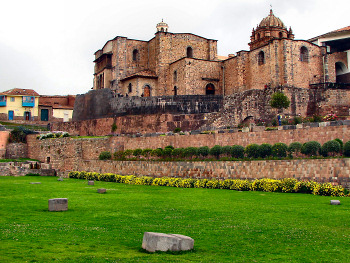
Convento Santo Domingo built over Inca foundations, Cusco
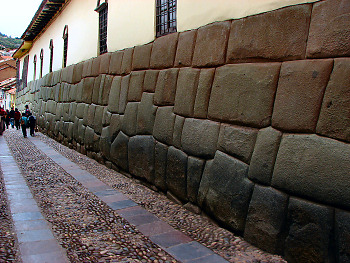
Calle Loreto, bordered by a large Inca wall, Cusco
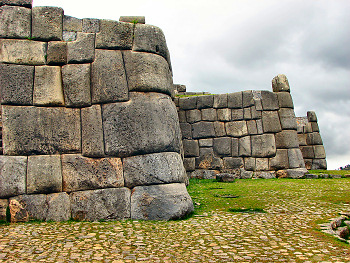
Sacsayhuaman Fortress Ruins, Cusco
Other Inca Sites
Fortunately, many other aspects if Inca deign were more easily seen at the smaller, outlying ruins sites. One of the more amazing of these was the ability of Incas stonemasons to join huge slabs of stone together tightly. At the interesting sanctuary at Ollantaytambo, at the northern end of the Sacred Valley, this is seen at perhaps its most impressive scale. The solid wall in the image below is actually comprised of six huge granite slabs spliced together by narrow stone joining pieces, giving it its name, The Wall of the Six Monoliths. The wall may be part of an unfinished structure, but to me it seemed as if there was no apparent use, and it simply may have been a way of showing off.
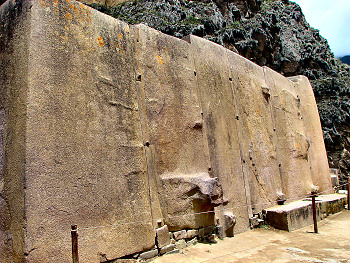
Stone wall composed of huge interloking stone slabs at Ollantaytambo
Another characteristic of Inca structures was the
propensity their builders had for locating them on steep mountaintops. A fairly mild example of this can be seen at the Ingapirca ruins, near Canar, Ecuador, shown below, which was the most northerly Inca site I was able to visit. The lofty heights of Inca constructs occasionally forced me to leave the bike behind for a while and make a tiring hike up to the location of the ruins.
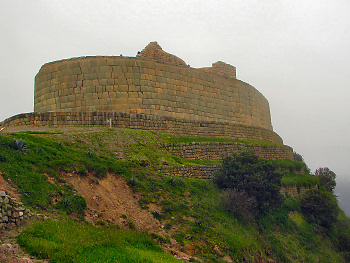
Ingapirca Ruins in Ecuador
There were two other facets of Inca architecture that made their structures stand out from the other types I saw during the Tour. The first was the use of stone for the walls of basic dwellings and structures such as baths, aqueducts, and roads, as opposed to exclusively for temples and important civic buildings as was often the case in other cultures. To be sure, the quality of the stone craft used was far superior on the more important edifices, which are the only places one can see the famous "perfect" joinery. Typical homes and minor buildings were made with much less precision, but with a level that was perfectly acceptable for their intended uses.
The other distinctive feature readily seen is the complete lack of decoration included in the stonework itself. While Angor, Pattadakal, and many other sites, were completely covered with intricate stone carvings, almost to the point of being overdone, Inca stoneworks are perfectly smooth and featureless. That is not to say that Inca buildings were unattractive. On the contrary, almost every interior wall of Inca buildings, and many exterior walls as well, contain large recessed niches where, before the conquest, beautiful works of art, or other important objects, were presumably displayed. That means, however, that a capable imagination is required when visting Inca ruins, more so than at some other ancient sites, in order to visualize what the these cities would have been like in their prime. Both of these factors can easily be seen in places like the magnificent Machu Piccu sanctuary, and many other small sites.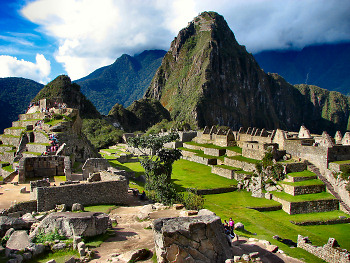
Remains of dwellings and temples at Machu Picchu, Peru
The Mayan World
In terms of grand cities, filled with impressive stone structures spread over a wide area, it is hard to beat the Mayans. Their society flourished in the northern sections of Central America, with most if the great cities being built during the Classic Period between 250 and 900 C.E. The largest cities from that time are assumed to have held populations numbering from 100,000 to 200,000 inhabitants, and extended for up to 60 square kilometers in the case of Tikal. With so many sites currently open to visitors it is close to impossible to visit them all, given the constraints of a long tour. I planned to visit nine during Stage 5, and managed to see all of them by the time I was through. Cycling to these ruins proved to be a little more pleasant, or at least less strenuous, than some of the other ancient sites I saw earlier had been. While all of the Mayan sites have many things in common, each also possesses one or more factors that make it distinctive from the others. Therefore it is worthwhile to see more than a few when visiting the area.
The first I came to was Copan, in Honduras. It was notable for its many excellent stelae elaborately carved with hieroglyphs and descriptive images. Most ancent Mesoaaerican cities had a Ball Court used for games or rituals that are still not completley understood, and Copan's was one of the nicest I saw. The ruins are also located in a particularly beautiful location, and have a splendid museum on site.
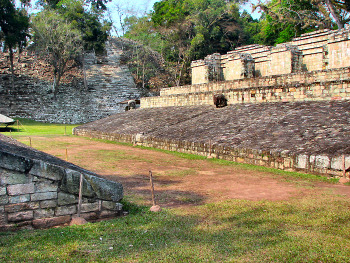
Ball Court at Copan, Honduras
Tikal, one of the largest of all Mayan cities, still contains an amazing collection of tall pyramids, most of them restored to a good condition. The most appealing feature of this site, in my mind at least, is that in addition to its large number of impressive ruins, it is surrounded by a beautiful rainforest in an expansive national park. That makes visiting Tikal both an amazing cultural, as well as natural, experience.
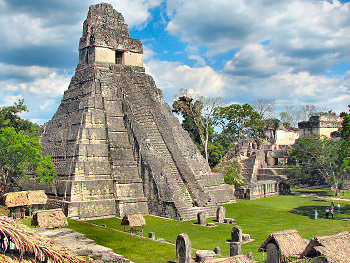
Temple 1 and the Acropolis at Tikal, Guatemala
Chitzen Itza, in Mexico's' Yucatan state, is one of the most visited of all Mayan ruins sites. That is due to its easy access, as well as its impressive collection of large buildings constructed in diverse styles. The site's central pyramid, El Castillo is probably the single most exquisitely restored building in the entire region. Visiting did require dealing with huge crowds, however.
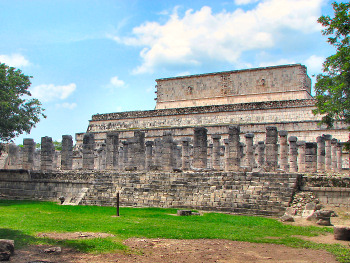
Group of the Thousand Columns at Chichen Itza,Yucatan, Mexico
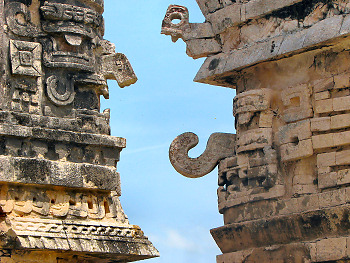
Ornamentations on The Nunnery at Chitzen Itza
That aspect could be avoided at some of the smaller sites, like Uxmal, Edzna, and Palenque, which often provided me the ability to be alone in the ruins of an ancient city, a truly enjoyable experience.
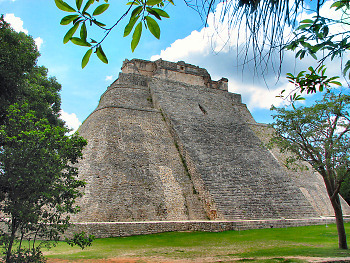
The Magician's Pyramid at Uxmal, Campeche, Mexico
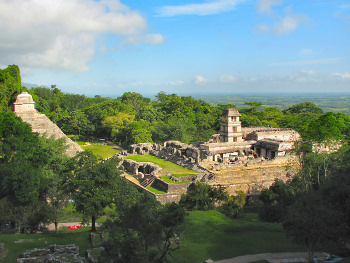
Palenque, Chiapas, Mexico
Mitla & Monte Alban
Contemporary to the Mayan classic period cities were the Zaoptec cities of the Oaxaca region in central Mexico. While the Zapotec civilization never extended over a great area, as its neighbors did, its culture was rather long lasting and its position, just north of the Isthmus of Tehuantepec, allowed it to act as a bridge between major cultures facilitating the spread of ideas throughout the region. The two sites I visited, Mitla, and Monte Alban, each show similarities, and some differences, to the cities of neighboring states. At Mitla, for example, stone decorations on buildings employ sharp, geometric friezes, in contrast to the graceful and almost botanical-appearing designs of Mayan carvings. At Monte Alban, on the other hand, a small ball court demonstrates the sharing of some cultural aspects between these nearby civilizations.
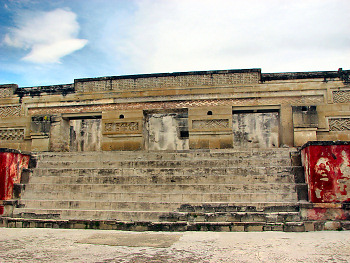
Mitla, Zapotec ruins near Oaxaca
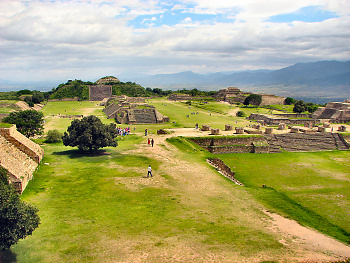
Monte Alban, Zapotec city near Oaxaca
Teotihuacan
Relatively little is known about Teotihuacán, the largest city in the Americas between 100 and 450 C.E., which was located not far from present day Mexico City. While there is still much debate about the culture that built it, one thing is clear, Teotihuacán was one of the most grandiose cites of the ancient world. With two of the largest pyramids in the World, broad promenades, colorful murals, and various other structures, it more closely resembles a modern city than any of the other ancient sites that I visited. Despite its proximity to one the largest modern cities, visiting the site by bike was surprisingly easy, though with the size of the site I might have liked to have had mine with me inside the ruins site as well. In any case, Teotihuacán, which was the last large ancient site of the Tour, provided a suitably humbling experience.
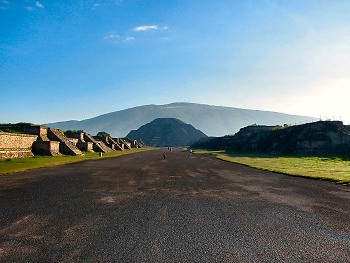
Avenue of the Dead and Pyramid del Luna, at Teotihuacan
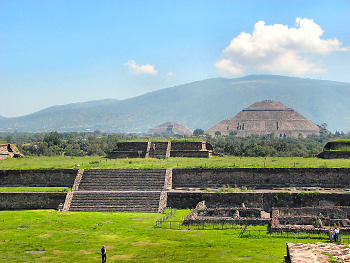
Pyramid del Sol and Pyramid del Luna (background), Teotihuacan
Connecting Threads
After my enjoyable experiences cycling to all of the great ancient cities shown above, and a number of equally interesting smaller sites as well, I now can clearly see two common factors that they all possess which are increasingly relevant for us today. The first of these is that, with absolute certainty, all of these magnificent cities were created by human hands, without making use of any stores of concentrated energy. Many people today may dismiss the ability of societies to create anything worthwhile without exploiting hydrocarbon reserves and modern technologies. However, these cities, most of which flourished for hundreds of years, and likely would have continued for centuries more were they not intentionally destroyed, clearly dispel that notion. Certainly, designing cultural and community properties to last is a strategy that pays huge dividends to those who chose that course. The fact that the buildings I saw in the ancient cites of the Tour were built with stone was a big part of that. Another was that the structures that these ancient cultures built in that way were worth preserving.
That fact leads to the second common factor; all of the ancient cities I saw appeared to me to have been specifically designed to be beautiful first and foremost. It is now hard for me to look at a modern BigBox monstrosity, and think back to the imposing Bayon Temple at Angkor, the inspirational views at Bagan, the intricate and whimsical carvings at Pattadakal and Copan, or the way sounds echo around in the cool expanses of Bete Amanuel church in Lalibela, and not come to the conclusion that I would rather have lived six hundred, or so, years ago. For it seems that we, who are said to be the wealthiest people the World has yet known, and who certainly have the tools and knowledge with which to create exceptionally beautiful civic artifacts, have, sometime in the past century, lost most of our will to do so. With an era rapidly approaching in which our entire society will need to be reconsidered, it would be nice if we could look back and remember the benefits of durable and beautiful cities built in a deliberate and sustainable way. I think that we will be needing many such places before much longer.
Previous | Next
Main Index | Pre-Tour Index
Post-Tour Index | Articles Index
Slideshows
Main Index Pre-Tour Post-Tour Articles Previous Next |
Contemporary Accounts
Ayutthaya
Diogo do Couto
Portuguese traveler and mercenary
Décadas da Ásia - ~1615
"The King comes out of the city, accompanied by the whole of the nobility, in barges richly gilded and covered with ornaments, with great display and noise of musical instruments. They proclaim that the King is about to order the waters to disperse; and, this is the great festival of the year. A mast is raised in the middle of the stream, adorned with silken flags, and a prize suspended for the best rower. All the contending boats put themselves in trim, and at a given signal start, with such cries, and shouting, and tumults, as if the world was being destroyed; the first who arrives carrying of the prize. But in the contest there is terrible confusion-boats running against and swamping one another, oars tangled and disentangled in a disorder admirable to look at from around. So that the people are not so barbarous, but that they imitate the ancient Trojans (as in the same manner, Eneas; when he arrived in Sicily, had the festival of his galleys, giving precious prizes to the most alert); and when these Siamese have won the prize, they return to the city with such rejoicings, shoutings, and tumultuous music, that the noise shakes both the waters and the land. Then the King having returned to the city, the people say he has driven back the waters, because these heathens attribute to their Kings all the attributes of God, and believe they are the source of all good."
Angkor
Zhou Daguan
Chinese Diplomat
The Customs of Cambodia - 1297
"In front of the royal palace, a great platform is built, capable of holding a thousand people, and decorated with lanterns and flowers. In front of it, at a distance of one hundred and twenty feet, another platform is built, one hundred and twenty feet high by laying pieces of wood end to end. This is done in the same way as a scaffolding for Buddhist stupas. Each night, three, four, five or six of these are built. On top of them, rockets and firecrackers are attached. The cost of these is met by the provinces and by the noble families. When night has fallen, the king is asked to watch the spectacle. The rockets are released and the firecrackers lighted. The rockets can be seen [about a mile] away. . . . The festival goes on like this for fifteen days. Every month there is a festival."
"When the king goes out, troops are at the head of the escort; then come flags, banners, and music. Palace women, numbering from three to five hundred, wearing flowered cloth, with flowers in their hair, hold candles in their hands, and form a troupe. Even in broad daylight, the candles are lighted. Then come other palace women, bearing royal paraphernalia made of gold and silver... Then come the palace women carrying lances and shields, [and] the king's private guards.... Carts drawn by goats and horses, all in gold, come next. Ministers and princes are mounted on elephants, and in front of them one can see, from afar, their innumerable red umbrellas. After them come the wives and concubines of the king, in palanquins, carriages, on horseback, and on elephants. They have more than a hundred parasols, flecked with gold. Behind them comes the sovereign, standing on an elephant, holding his sacred sword in his hand. The elephant's tusks are encased in gold."
"In this country, it is the women who are concerned with commerce... Every day, a market takes place which begins at six in the morning and ends at noon. There is no market made up of shops where people live. Instead, people use a piece of matting, which they spread out onto the earth. Each of them has her own location, and I believe that fees are charged for these locations."
Bagan
Marco Polo
Venetian traveler and merchant
The Travels of Marco Polo - 1298
"And when you have travelled those 15 days through such a difficult country as I have described, in which travellers have to carry provisions for the road because there are no inhabitants, then you arrive at the capital city of this Province of Mien, and it also is called Mien, and is a very great and noble city. The people are Idolaters and have a peculiar language, and are subject to the Great Khan.
And in this city there is a thing so rich and rare that I must tell you about it. You see there was in former days a rich and puissant king in this city, and when he was about to die he commanded that by his tomb they should erect two towers [one at either end], one of gold and the other of silver, in such fashion as I shall tell you. The towers are built of fine stone; and then one of them has been covered with gold a good finger in thickness, so that the tower looks as if it were all of solid gold; and the other is covered with silver in like manner so that it seems to be all of solid silver. Each tower is a good ten paces in height and of breadth in proportion. The upper part of these towers is round, and girt all about with bells, the top of the gold tower with gilded bells and the silver tower with silvered bells, insomuch that whenever the wind blows among these bells they tinkle. The tomb likewise was plated partly with gold, and partly with silver. The King caused these towers to be erected to commemorate his magnificence and for the good of his soul; and really they do form one of the finest sights in the world; so exquisitely finished are they, so splendid and costly. And when they are lighted up by the sun they shine most brilliantly and are visible from a vast distance."
Vijayanagara
Domingo Paes
Portuguese traveler
Notes - 1520
"Going forward, you have a broad and beautiful street, full of rows of fine houses and streets of the sort I have described, and it is to be understood that the houses belong to men rich enough to afford such. In this street live many merchants, and there you will find all sorts of rubies, and diamonds, and emeralds, and pearls, and seed-pearls, and cloths, and every other sort of thing there is on earth and that you may wish to buy. Then you have there every evening a fair where they sell many common horses and nags, and also many citrons, and limes, and oranges, and grapes, and every other kind of garden stuff, and wood; you have all in this street."
"The size of this city I do not write here, because it cannot all be seen from any one spot, but I climbed a hill whence I could see a great part of it; I could not see it all because it lies between several ranges of hills. What I saw from thence seemed to me as large as Rome, and very beautiful to the sight; there are many groves of trees within it, in the gardens of the houses, and many conduits of water which flow into the midst of it, and in places there are lakes; and the king has close to his palace a palm-grove and other rich-bearing fruit-trees."
"This is the best provided city in the world, and is stocked with provisions such as rice, wheat, grains, Indian-corn, and a certain amount of barley and beans, moong, pulses, horse-gram, and many other seeds which grow in this country which are the food of the people, and there is large store of these and very cheap; but wheat is not so common as the other grains, since no one eats it except the Moors."
Lalibela
Francisco Alvares
Portuguese priest
The Prester John of the Indies - 1524
"I weary of writing more about these buildings, because it seems to me that I shall not be believed if I write more ... I swear by God, in Whose power I am, that all I have written is the truth."
Tiwanaku
Pedro Cieze de Leon
Spanish Conquistador
Travels of Pedro Cieze de Leon - 1550
"Tihuanaco is not a very large village, but it is celebrated by the great edifices near it, which are certainly things worth seeing. Near the buildings there is a hill made by the hands of men, on great foundations of stone. Beyond this hill there are two stone idols, of the human shape and figure, the features very skilfully carved, so that they appear to have been done by the hand of some great master. They are so large that they seem like small giants, and it is clear that they have on a sort of clothing different from those now worn by the natives of these parts. They seem to have some ornament on their heads. Near these stone statues there is another building. Their antiquity and the want of letters, are the causes why it is not known who built such vast foundations, and how much time has since elapsed; for at present there is only a wall very well built, and which must have been standing for many ages. Some of the stones are much worn. At this part there are stones of such enormous size that it causes wonder to think of them, and to reflect how human force can have sufficed to move them to the place where we see them, being so large. Many of these stones are carved in different ways, some of them having the shape of the human body, which must have been their idols. Near the wall there are many holes and hollow places in the ground. In another, more to the westward, there are other ancient remains, among them many doorways, with their jamb; lintels, and thresholds, all of one stone. But what I noted most particularly, when I wandered about over these ruins writing down what I saw, was that from these great doorways there came out other still larger stones, upon which the doorways were formed, some of them thirty feet broad, fifteen or more long, and six in thickness. The whole of this, with the doorway and its jambs and lintel, was all one single stone. The work is one of grandeur and magnificence, when well considered. For myself I fail to understand with what instruments or tools it can have been done; for it is very certain that before these great stones could be brought to perfection and left as we see them, the tools must have been much better than those now used by the Indians. It is to be noted, from what now appears of these edifices, that they were not completed, for there is nothing but these portals, and other stones of strange bigness which I saw, some of them shaped and dressed ready to be placed on the edifice, which was a little on one side. Hero there was a great idol of stone, which must have been placed there to be worshipped. It is rumoured that some gold was found near this idol; and all round there are more stones, large and small, all dressed and fitted like those already described.
There are other things to be said concerning Tiahuanaco, which I pass over, concluding with a statement of my belief that this ruin is the most ancient in all Peru. It is asserted that these edifices were commenced before the time of the Yncas, and I have heard some Indians affirm that the Yncas built their grand edifices at Cuzco on the plan which they had observed at the wall near these ruins. They even say that the first Yncas thought of establishing their court at Tiahuanaco. Another remarkable thing is, that in all this district there are no quarries whence the numerous stones can have been brought, the carrying of which must have required many people."
Cusco
Francisco Pizarro González
Spanish conquistador
Letter to Charles V - 1533
"This city is the greatest and the finest ever
seen in this country or anywhere in the Indies...
We can assure your Majesty that it is so beautiful
and has such fine buildings that it would be
remarkable even in Spain."
Pedro Pizarro
Spanish conquistador
Relation of the discovery and conquest of the kingdoms of Peru - 1571
"To return to the matter of Cuzco, [I will say that] on top of a hill they had a very strong fort surrounded with masonry walls of stone and having two very high round towers. And in the lower part of this wall there were stones so large and thick that it seemed impossible that human hands could have set them in place. . . And they were so close together, and so well fitted, that the point of a pin could not have been inserted in one of the joints. The whole [fortress was built up in] terraces and flat spaces. There were so many rooms that ten thousand Indians could get within them. All these rooms were occupied by and filled with arms, lances, arrows, darts, clubs, bucklers, and large oblong shields under which a hundred Indians could go, as though under a mantle, in order to capture ions. There were many morions made of certain canes very well woven together and so strong that no stone nor blow could penetrate them and harm the head which wore the morion. There were also, here in this fortress certain stretchers in which the Lords traveled, as in litters. There were here many Indians who guarded these stores and who saw to it that these terraces and rooms were kept in repair if it rained in the winter-time. This fortress would have been impregnably strong had it been provided with water and [it had] great labyrinths and rooms which I never saw completely and never understood."
Teotihucan
Fray Bernardino de Sahagun
Spanish priest
Florentine Codex, Book 10 - 1540-85
"It is called Teoti[h]uacan. And when the rulers died they buried them there. Then they built a pyramid over them… And they built the pyramids of the sun and moon very large, just like mountains. It is unbelievable when it is said they are made by hands, but giants still lived there then."